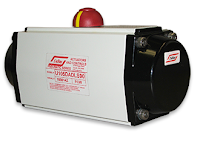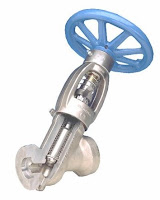 |
| Scotch-yoke actuators (Morin) |
movement and are designed to open, close, or position a quarter-turn valve. These include ball valves, plug valves, butterfly valves, or other types of 90 degree rotational valves.
The basic design variations of pneumatic valve actuators are as follows:
- Rack and pinion
- Scotch-yoke
- Rotary vane
Let's review each of these in detail:
Rack and Pinion Actuators
 |
| Rack and pinion actuator (Unitorq) |
Scotch-yoke Actuators
 |
| Scotch-yoke actuators internal view. |
Rotary Vane Actuators
 |
| Rotary vane actuator animation. |
These style of valve actuators can all be secured with direct acting or spring return versions. Direct acting actuators use the air supply to move the actuator in both directs (open and close). Spring return actuators, as the name describes, uses springs to move the actuator back to its "resting" state. Converting a version from direct acting to spring return is done through simple modifications, typically just adding an external spring module, or removing the end caps from rack and pinion actuators and installing several coil springs.
When considering the choice of pneumatic valve actuators, your decision comes down to size, power, torque curve and the ease of adding peripherals. To ensure that your valve actuation package will be optimized for safety, longevity, and performance, the advice of a qualified valve automation expert should be sought out. That expert will be able to help you with the best selection of the appropriate valve actuator for any quarter turn valve application.
For more information on valve actuation, contact Piping Specialties, Inc.
https://psi-team.com
800-223-1468


